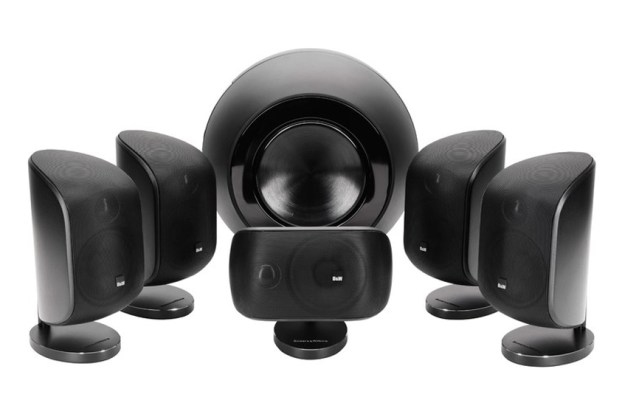
- Fantastic subwoofer
- Satellites deliver excellent imaging and separation
- Innovative mounting options
- Satellites aren’t quite on par with the sub
- Spring-loaded binding posts can’t accept heavy-gauge speaker cables
- Subwoofer is quite expensive
If you’re the type of home theater buff who craves the lush, lavish audio performance that you believe only large tower speakers can deliver; but don’t want those oversize cabinets diverting your audience’s attention from your wafer-thin HDTV or video projection screen, you must arrange for a personal audition of Bowers & Wilkins’ MT-60D home-theater speaker system.
The bundle consists of five of B&W’s innovative M-1 loudspeakers and its absolutely stunning PV1D subwoofer. Each M-1 is a two-way speaker consisting of a one-inch aluminum-dome tweeter (featuring B&W’s Nautilus tube design) and a four-inch fiberglass woofer. These full-range speakers are rated to deliver frequency range down to 55Hz, avoiding the sonic hole that sometimes occurs when small speakers are paired with a subwoofer. The M-1s are capable of standing alone, but we can’t imagine doing that after hearing them paired with the PV1D.
Features and design
The M-1 cabinets are fabricated from steel and are available in your choice of a matte black or matte white finish, with matching perforated steel grills. The speakers come mounted to tabletop stands, the bases of which are drilled through so you can run your speaker cable inside and connect it to spring-loaded bindings hidden inside.
When you remove the footpad to expose the bindings, you’ll discover a Torx driver conveniently attached. Loosen a screw on the stand and you can tilt the speaker back at an angle, or flip it to a horizontal orientation to lower its profile (this is particularly useful when setting the center channel beneath your TV). The B&W logo is attached to a spring-loaded peg, so you can pull it away from the grill and rotate it to match. Alternatively, you can remove the base altogether and mount the speakers to the wall (in either a vertical or horizontal orientation) using the provided brackets (which have integrated binding posts). If you’d prefer to use floor stands, B&W sells an attractive set for $150 each.

Like its predecessor, the PV1D is roughly spherical – somewhat resembling a bowling ball but twice as heavy, tipping the scales at 41 pounds. A 400-watt Class D amp drives twin eight-inch long-throw drivers, one on each side of the pressure vessel cabinet. The drivers are fabricated from a composite of paper, aluminum, and Kevlar. A plethora of inputs are hidden on the bottom of the unit, including stereo line-level RCA inputs, stereo speaker-level inputs (B&W provides a special Molex cable for use with amplifiers that don’t have a pre-amp sub output), two trigger inputs (one for switching the sub between its on and standby states, the other for toggling between two EQ presets), an RS-232 serial input (for use with a PC running the aforementioned SubApp software or to control the sub using a home-control system), and a mini USB input (for updating the sub’s firmware).
Audio performance
We auditioned the MT-60D system by connecting it to an Onkyo TR-N818 A/V receiver and a Panasonic Viera TC-55LE54 HDTV. We recalibrated the receiver and corrected for the room before we started our listening test. To evaluate the speaker system’s musical chops, we first queued up the newly remastered, 5.1-channel, 24-bit FLAC version of Mike Oldfield’s Tubular Bells, which we’d purchased from Bowers & Wilkins’ Society of Sound service. This is a remarkable recording, and the M-1 speakers delivered it with precision and flair. We also used two of our old standby surround-sound audio recordings in our evaluation: the Blue Man Group’s The Complex and Frank Zappa’s Quadiophiliac, both of which are encoded in DTS surround sound with 24-bit resolution and a 96kHz sampling rate.
We then switched over to our Blu-ray tests, using Spiderman 3 and the James Bond film Quantum of Solace. During the chase scene that opens the latter film, subtle facets of the soundtrack – the click of the Aston Martin’s gear shift, the clink of the ammo belts, and the crunch of gravel as the cars tear through the rock quarry – become lost in the roar of the car’s engine when played back through lesser speakers. The M-1s rendered these and other audio details – the snick of a spring-loaded knife, the crunching sound of an enemy’s fingers being broken during a fight – with aplomb.
Conclusion
As good as the M-1’s are, they’re not the type of speaker that makes you really sit up and take notice of them—at least not when your reference speakers are high-end full-sized towers. The PV1D, on the other hand, is an absolutely phenomenal subwoofer. In both our music and Blu-ray tests, it rendered bass notes and low-frequency effects that absolutely punched us in the gut. Is it “too good” for pairing with the M-1s? Not at all – we never got the impression that the sub outclassed the satellites – but if you have the room, we would have no qualms recommending that you pair it with a set of larger full-range speakers.
Highs
- Fantastic subwoofer
- Satellites deliver excellent imaging and separation
- Innovative mounting options
Lows
- Satellites aren’t quite on par with the sub
- Spring-loaded binding posts can’t accept heavy-gauge speaker cables
- Subwoofer is quite expensive
Editors' Recommendations
- Bowers & Wilkins’ wireless earbuds get better battery life and longer range
- Bowers & Wilkins’ upcoming Px8 are so secret, we can only reveal the price
- How to connect Alexa to your home speakers


